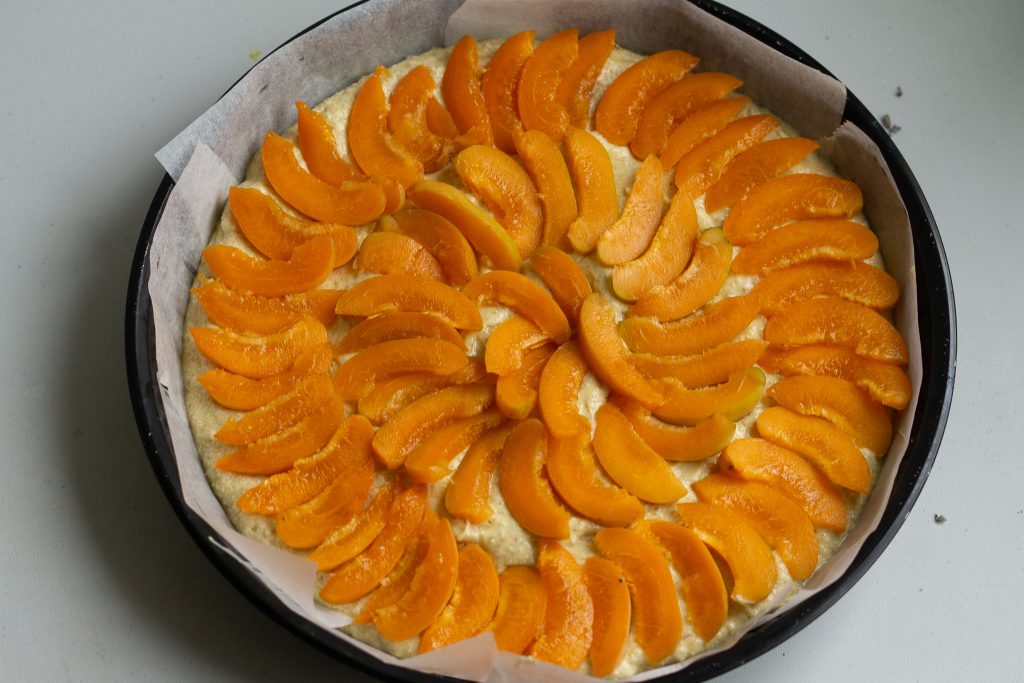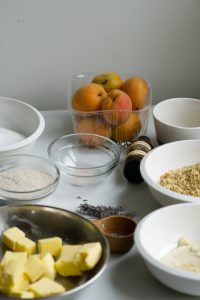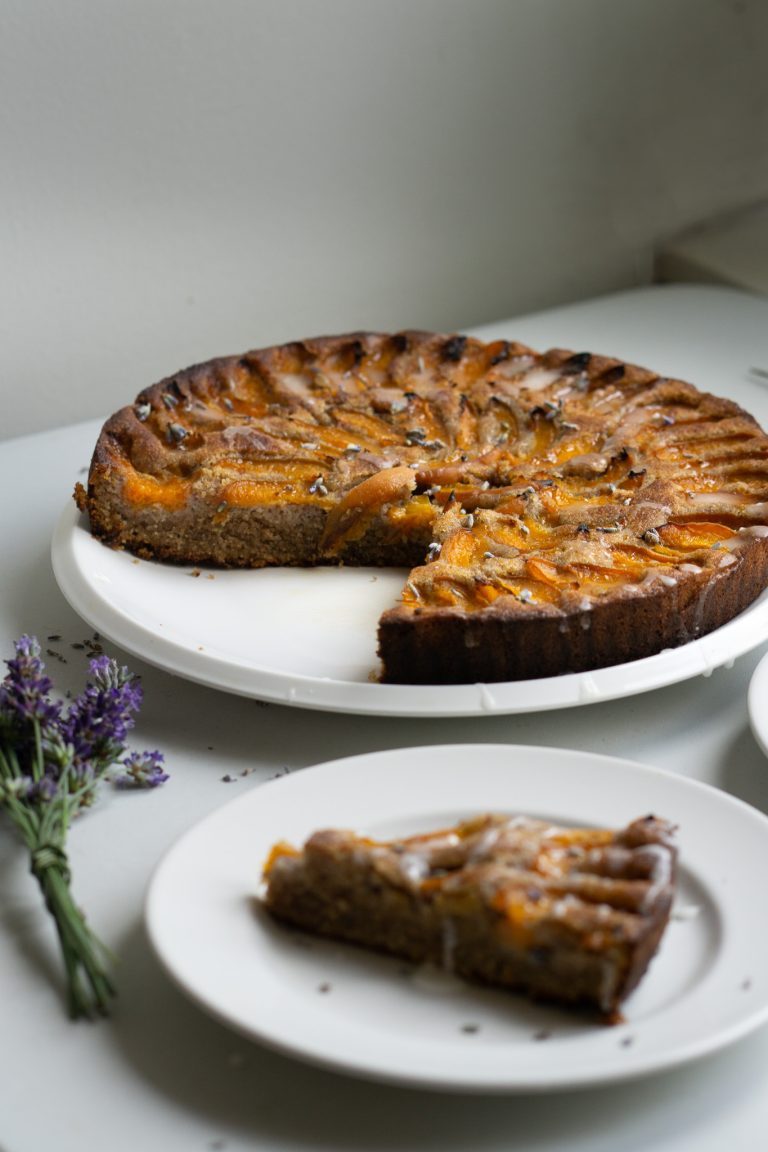Apricot and lavender cake is a beautiful bake that combines the sweet and tangy flavor of apricots with the floral aroma of lavender. Perfect for any occasion, from a casual afternoon tea to a lighter cake-based dessert at a formal dinner party.
Best made with fresh ripe apricots and a touch of homemade lavender extract, it’s a celebration of summer in a sweet treat, and it’s the creamy lavender-infused icing that really “takes the cake” to the next level.
A reason to celebrate apricot season
I have a particular love of apricots that stems all the way back to my childhood. When people ask what’s the one food that you remember and wish you could eat again as an adult, most people would probably say their mum’s Sunday roast or lollies they were only allowed to have on the rare occasion; For me, it’s my nanna’s apricot jam. and I’ve tried other apricot jams, even though they contain the exact same ingredients, they never taste quite the same.
I find Apricot season to be a delightful time of the year, from the beautiful blossoms to the abundant and juicy fruit. Not only are they a world of flavour, but apricots are also a great source of vitamins and minerals, a perfect nutritious snack eaten whole and also make an equally amazing and (in my humble opinion) underrated ingredient. Apricots have a huge range of applications from the sweet to the savoury. Paired with meats as in Moroccan tagines or mum’s apricot chicken, and equally likely to be featured in pies, jams and tarts of many different incarnations. But I also find apricots to make a great addition to salads, smoothies, skewers, reductions, glazes and so much more!
“In the apricot’s embrace, we taste the warmth of summer and the promise of sweeter days ahead.”
unknown
So for this and many other reasons, I absolutely love apricot season, but unfortunately, it’s so fast that I usually miss it at its peak! So, when I finally noticed punnets of beautiful ripe apricots hitting the stalls at the Irish farmer’s markets… I couldn’t wait to do something in the kitchen to celebrate this incredible and succulent fruit.
Also Read: Incredible Hazelnut & Caramelised Pear Cake
Baking with fruit…
Baking with fresh fruit can add a burst of flavour, moisture, and natural sweetness to your baked goods. It can also have some not-so-appetizing results! So here are some of my favourite tips to help you successfully incorporate fresh fruit into your baking:

- Choose ripe fruit: Opt for ripe fruit that is at its peak flavor and sweetness… but not overripe. Ripe fruit will provide the best taste and texture in your baked goods. Overripe food will turn to mush, will not hold its shape and will add moisture that can completely destroy a good cake.
- Adjust sweetness: Depending on the sweetness of the fruit and your personal preference, you may need to adjust the amount of sugar in the recipe. Sweeter fruits like berries may require less added sugar, while tart fruits like rhubarb may need a bit more. This recipe has been adjusted to account for ripe apricots, and also the addition of the syrup/icing at the end but in general most ripe stone fruit will bring extra sweetness to the bake and should be considered in the overall sugar levels.
- Prepare the fruit properly: Wash and dry the fruit thoroughly before using it in your recipe. Remove any stems, leaves, seeds, or pits, and chop the fruit into the desired size or shape. By desired I mean, consider the recipe and the texture you want to achieve in the final bake.
- Coat the fruit with flour: Not necessarily relevant here, but easily one of the best tips I’ve been given since starting to bake. To prevent the fruit from sinking to the bottom of the baked goods, toss it in a small amount of flour before adding it to the batter. This helps the fruit distribute evenly throughout the batter.
- Adjust baking time and temperature: Keep in mind that adding fresh fruit to a recipe can affect the baking time and temperature. Hence why this bake may seem unusually long in comparison to another cake with a similar batter. The extra moisture from the fruit may require longer baking or a lower temperature to ensure the center of the baked goods cooks properly.
- Consider macerating the fruit: Macerating involves lightly tossing the fruit with sugar to draw out its juices and intensify its flavor. This step can be particularly useful when working with firmer or less juicy fruits. Let the fruit sit for a while before incorporating it into the recipe.
- Use a supportive batter: Some fruits release more moisture during baking, which can make the baked goods soggy. Consider using a sturdy batter, such as a thicker cake or muffin batter, to better support the fruit and maintain the structure of the baked goods.
- Balance moisture with other ingredients: If your fresh fruit is particularly juicy, you may need to adjust the moisture content of the recipe. This can be achieved by reducing the amount of other wet ingredients, such as milk or yogurt, or increasing the dry ingredients slightly.
- Experiment and have fun: Baking with fresh fruit allows for creativity and experimentation. Don’t be afraid to try different combinations and flavors. Whether you’re making pies, cakes, muffins, or tarts, fresh fruit can add a delightful twist to your baked treats.
Cooking with lavender
Cooking with lavender can add a unique and floral flavor to your dishes. It pairs well with both sweet and savory, such as lavender shortbread, lavender cupcakes or even lavender chicken and it has a long history in baking. When cooking with lavender, it’s super important to use it sparingly to avoid overpowering the dish. You can quickly turn something from deliciously floral to a mouthful of dishwashing detergent with only the smallest of oversights so be careful with your quantities out there. It’s also important to use culinary-grade lavender, as other types may be too strong in essential oils and/or contain pesticides.

5 ways to cook with lavender
Lavender is a beautiful and fragrant plant that can add a unique flavour to many dishes. But unless you’re lucky enough to have some plants flowering near you, it’s likely you’ll have to buy at least 100g or so when purchasing it for this recipe. Because it’s so light, that’s actually a surprising amount of lavender! So, here are some fun ways you can set about using it up.
- 1. Infuse honey with lavender by heating (very gently) honey and dried lavender buds in a saucepan and then straining the mixture. (Or by leaving some buds in a jar of it for a few weeks)
- 2. Make lavender tea by steeping fresh or dried lavender buds in hot water for a few minutes. Add honey and lemon for a soothing and fragrant drink.
- Create a lavender rub for meats by blending dried lavender buds with salt, black pepper, and other spices of your choice. Rub this mixture onto chicken, pork, or lamb before cooking.
- Bake with it by adding dried lavender buds to your favourite cookie or cake recipe, or also try steeping it in milk or cream, to infuse the flavour for use in dairy-based desserts such as panna cotta and ice cream.
- Use lavender in cocktails by creating a simple syrup with it and keeping some petals aside for a beautiful purple garnish.
A note on ingredients:

You will find that I say this in every blog post, but quality ingredients really do matter. Here’s my take on what’s needed to get the best results from this bake.
- Flour: You can use regular flour for this recipe but since the ingredients are so wholesome I choose to use spelt flour for an extra level of nutrition.
- Butter: There are a few other sources of fat in this bake that also bring the flavour, so if you need to go with a dairy-free butter you could probably get away with it. Being a dairy girl myself, I’ll always advocate for full-strength butter at its best.
- Apricots: You want your apricots ripe – but not so overripe they literally fall apart as you peel them as you need them to keep their shape when being baked.
- Walnut meal: It’s most likely you’ll have to blend your own meal from fresh walnuts, I’ve not yet come across it in the shops, but I probably wouldn’t buy it pre-made anyway because walnuts are such a beautiful source of unsaturated fat, they spoil easily. And with that much surface area exposed to oxygen, it’s likely your meal will go rancid within days of being prepared. Always make it fresh.
- Vanilla: In most dishes, I opt for fresh vanilla or a vanilla paste, but as it’s not one of the predominant flavours in this cake, extract does fine on this occasion.

Apricot and lavender cake
Equipment
- 1 9-inch/23-cm cake pan
- 1 baking paper
- 1 stand or hand mixer
Ingredients
- 185 gram unsalted butter
- 2 tbsp olive oil
- 220 grams caster sugar (or other fine sugar)
- 1 cup walnut meal (preferably home made)
- 1 1/4 cups almond meal
- 4 large eggs (whisked)
- 3/4 cup white spelt flour
- 1/2 tsp vanilla extract (or vanilla paste)
- 1 tsp lavender flowers (or flower petals)
- 5 whole apricots sliced (ripe but not overripe)
- 1/8 tsp salt
Optional icing
- 50 grams icing sugar
- 1 tbsp lemon juice (doesn't need to be fresh)
- 1 tsp lavender water ((optional))
- 1 tsp lavender flower buds ((optional for garnish))
Instructions
- Preheat the oven to 375ºF/190ºC
For the cake
- Place the butter, oil, sugar and almonds in a stand mixer and beat on medium-high speed until light and fluffy. Add the eggs in small additions and continue to beat until well incorporated.
- Fold in the walnut meal, almond meal, flour, vanilla, olive oil, the lavender flower buds broken up and ⅛ teaspoon salt.
- Line the base and sides of a 23-cm cake pan with parchment paper. Arrange the apricot pieces in a circular motion until you have covered the bottom of the tin. It helps to place the plumpest side down and the thinnest side attached to the next piece.
- Pour in cake batter and level the top. Bake in the oven for 70 to 80 minutes, cover it with foil if it starts to brown.
For the icing
- Whisk together the confectioners’ sugar, lemon juice and (lavender water if using) to get a light, pourable icing, adjusting the amount of sugar or juice if needed.
- As soon as the cake comes out of the oven, brush half the icing on top. (the cake will absorb it) Wait for the cake to cool and then add the remaining icing on top and cover with lavender flowers.
Did you make this recipe?
Don’t forget to share the love and tag us Instagram @thetastyspoonful or message us on Facebook at “The Tasty Spoonful”
Looking for more decadent recipe inspiration? Why not try these:
Until next time. Keep following, liking, sharing, commenting and cooking, and may your every spoonful be tastier than the last!




